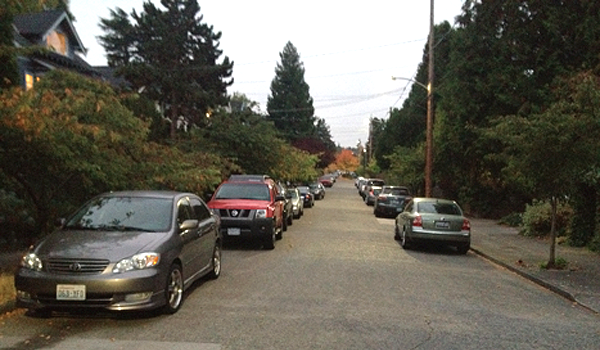That Parking Spot In Front of Your House Doesn’t Belong to You
I live on a single family residential street in Seattle, and in the evenings, it looks like this:

This makes me wonder sometimes: why is the city in the business of paving and maintaining three lanes of street when only one of them is actually moving cars? In fact, many people in my neighborhood have a driveway or a garage (and zoning requires on-site parking for any new construction) but they still choose to park in the street, presumably so they can use their garage for something else.
Next obvious question: Why should local zoning require on-site parking when hardly any one is using their on-site parking for parking?
Third, and perhaps most interesting question: If we think on-site parking has better uses than parking, could we elect to use our street parking for better uses as well?
Think about it. Most of us in single family neighborhoods have a proprietary relationship with the street parking spot in front of their house. We think: “someone is parked in MY spot.” This is understandable on a logical level when there is a foot of snow outside and someone has shoveled out a spot, but it’s much less understandable when it’s just part of the city right-of-way.

< Noriega Street Parklet, San Francisco – photo by Wells Campbell Photography >
Given that people do have this relationship with the parking spot in front of their house, what if we enabled them to do something other than park there? Some compact neighborhoods have taken to putting bike corrals or patios in parking spots, provided a reasonable percentage of the neighbors agree.

< A car-shaped bike rack occupies a parking space on Capitol Hill in Seattle >
But what if we could do this, and more, in single family neighborhoods?The transformation of street parking in single family neighborhoods could make even more sense since there is more often room to spare in those parking lanes. Not to mention that if you have zero, or even one car per household, you’re not really allowed to do anything else with that space, so you’re losing out relative to your multi-car neighbors, which isn’t really fair.
What if cities allowed residential blocks to apply to convert those parking lanes to whatever they wanted to, including cottages, bike lanes, extra garden space, public p-patches or dedicated car-share parking? Even better, what if our cash-strapped cities started monetizing the value in those two lanes and allowing neighborhoods to do whatever they wanted (including parking there) as long as they rented out the space, and generally agreed on a plan? The drive lanes in the middle of the street would be conserved, we might find ourselves with more neighborhood parks, or perhaps more little cottages permeating the urban fabric. We might even find new neighborhood amenities in these spaces that we hadn’t even thought of.
People are ingenious. There is wasted space in the “parking” lanes of our single family neighborhoods. Let’s build some frameworks that open up these spaces to human ingenuity, and see if we can’t get more value out of them.
A-P Hurd is a developer at Touchstone in Seattle and is a Runstad Fellow in the College of Built Environments at the University of Washington. She is the author of a recent book of practical strategies to get to better cities and stronger economies using less energy: The Carbon Efficient City, recently published by University of Washington Press.
This post originally appeared on the Atlantic Cities.

